The 3rd Asia-Pacific CBR Congress
Putting disability on the agenda in Cambodia
Disability in Cambodia
While data can vary considerably, Cambodia is estimated to have one of the highest rates of disability for a developing country1 with more than half a million people2 living with disability, one fifth of whom have amputations.3 People with disabilities have very limited access to appropriate treatment, rehabilitation services and vocational training. These barriers make it incredibly difficult for people with disabilities to participate fully and equally in community life.
CDMD’s approach to Disability Inclusive Development
The Cambodian Development Mission for Disability (CDMD) has a long history of providing rehabilitation and supporting people with disabilities in Cambodia. In 2009, the loss of a major funding source as a result of the global financial crisis led CDMD to re-evaluate its program design. CDMD’s new approach was to adopt a more comprehensive, rights-based approach to disability inclusion. The new approach meant the focus shifted from just providing rehabilitation to working with communities, partners and the government to encourage disability inclusion.
To design the project, CDMD facilitated a workshop with staff from CDMD, people with disabilities and their families, disability organizations and representatives from the government. Together, we discussed the challenges facing people with disabilities in Cambodia and developed strategies to support these issues. It was these findings that guided CDMD’s approach to disability inclusive development.
How is the project implemented?
Community level: The project has approximately 150 community volunteers (of which 23 are people with disabilities) who raise awareness of disability, identify people with disabilities and assist people with disabilities to access education, healthcare and rehabilitation. Community supervisors, many of whom were field workers with CDMD prior to the program redesign, support the establishment of self-help groups and income generation. These groups provide a space within communities where people with disabilities can come together to share experiences, learn advocacy techniques and communication skills, and work together to earn an income through seed grants.
Government level: Establishing strong links with the government is crucial to ensure a sustainable approach to disability inclusive development in Cambodia. At the commune level (this is the fourth level of organization in Cambodia; national then province then district then commune then village) CDMD works with local government to establish Community Disability Committees (CDCs). These committees have five members: a person with a disability, a representative from the health center, a school master/teacher, a religious leader, and a member of the commune council. With training support from the community supervisors, the CDCs develop action plans towards disability inclusive practices and advocate to Commune Councils to develop disability inclusive commune development plans. The religious leader in the group conducts awareness raising activities to reduce stigma and discrimination within the community.
Working together: The 36 established CDCs work with the network of community volunteers. For example, if a member of the community requires a wheelchair they may approach the CDC, who will then work with a community volunteer to source the wheelchair or refer them on to a service where wheelchairs are available.
What is most effective?
CDMD strives to ensure disability is on the agenda at both the community and national level. This has helped more children with disabilities to attend school and has reduced stigma within communities, enabling people with disabilities to participate in community life.
Beyond the changes seen in the community, one of the successes of CDMD’s work is the way we engage people with disabilities to deliver their work. Over 15 per cent of CDMD community volunteers have a disability. Molika is one such volunteer; at fifteen years of age Molika was referred by CDMD for surgery to improve his vision impairment. Although the surgery was not successful, Molika has maintained an ongoing relationship with CDMD since then. Today, at 24 years of age, he is an active community volunteer with CDMD and role model for people with disabilities. After receiving training, he took on the community volunteer role as an opportunity to challenge the misconception that people with disabilities can’t do anything. He saw it as a chance to support others in the way CDMD supported him.
Molika’s story shows how CDMD strives to find positive outcomes for people with disabilities. By ensuring active participation in project implementation, CDMD is improving the self-confidence of people with disabilities and helping challenge community perceptions thereby reaping strong benefits for the individual and the wider community.
What are the challenges?
- CDMD has found the high levels of poverty in Cambodia make it difficult for volunteers to spend significant time undertaking unpaid work. To help motivate and maintain volunteers, CDMD pays a small per diem to cover transport costs and one meal for each day spent volunteering.
- While CDMD takes steps to actively involve people with disabilities in the implementation of the project, the majority of people with disabilities involved are visually impaired or have minor physical impairments. CDMD has specialist skills supporting the visually impaired, yet is focused on widening its reach to support people with a range of disabilities and high support needs. This challenge is also seen in the gender breakdown of CDCs: CDMD encourages equal numbers of women and men, yet only 15 per cent of CDC members are women.
- One of the successes of CDMD’s work is the progress they have made in supporting schools to be more physically accessible. However, CDMD doesn’t yet have the capacity to work with teachers to improve their skills for teaching children with disabilities. In some cases, children have been placed in mainstream schools without the relevant support to ensure they receive a good quality education. CDMD is linking up with inclusive education NGOs to place children with disabilities in schools where they have the appropriate support.
- Sustainability is an ongoing challenge for CDMD. Despite building strong relationships with the government, CDMD has found it difficult to secure ongoing government funding. Without this support, costs to support the CDCs and community volunteers will not be met beyond the life of the project. In response, CDMD will engage in more targeted advocacy with national level bodies in the next phase of the project.
Inclusive development in practice
CDMD highlights two key factors for effective inclusive development in its work:
1.Empowering people with disabilities to advocate for their rights
CDMD adopts strategies that seek to empower people with disabilities to advocate for their rights and gain skills that enable them to have greater control over their lives. As of July 2012, CDMD had established 105 self-help groups with 7 to 15 members each.
Self-help groups have developed advocacy skills, received small loans for livelihood activities, networked with local governments and participated in community activities. While this is a strong foundation, the 2012 evaluation notes that additional capacity building will be required for the self-help groups to function independently of CDMD.
CDMD also works with existing Disabled People’s Organisations (DPOs) operating at the district level, and plans to build the capacity of these organisations to set up self-help groups, rather than doing this directly. DPOs have received training in rights, project cycle management, proposal and report writing and disability law, etc. They are aiming to advocate to government for inclusive education and healthcare and inclusion of disability issues in commune development plans. CDMD is developing a partnership with the national level DPO, Cambodian Disabled People’s Organisation, which will be important to increase sustainability and avoid duplication of efforts.
2.Working together with government and networking with other community based organisations for coordinated, sustainable projects
CDMD clearly shows the benefits of working closely with government ministries and other organisations. Through building relationships at all levels of government, CDMD has built strong support for its activities within the Ministry of Social Affairs, Veterans and Youth Rehabilitation. The Ministry recognises CDMD as an important partner and recommends that self-help groups and CDCs be promoted in all communes. Unfortunately, this support from government has not yet resulted in a financial contribution towards the project.
At the local level, establishing the CDCs has proved to be a successful strategy for disability inclusion. With some initial training on disability inclusion, CDCs have begun addressing barriers to inclusion within their local communities. Strategically selecting members of CDCs who are influential within the community has helped to make these committees effective. What has resulted is a small network of champions within each commune who can advocate for disability inclusion within their own spheres of influence. With some additional support, the CDCs have potential to become sustainable structures for disability inclusion at the local level.
LESSON 1
Ensuring people with disabilities are active participants in project implementation not only provides opportunities to improve self-confidence, but also challenges community perceptions about the contributions people with disabilities can make in their community.
LESSON 2
Establishing Community Disability Committees (CDCs) with influential community members is a key to creating change at both the community and government level.
PROGRESS TOWARDS INCLUSION
- In the two & a half years of project implementation over 800 people with disabilities or their family members have taken part in vocational training.
- Of these people, almost 95 per cent continue to work in that vocational field today.
- More than 1100 people with disabilities received a livelihood loan in the past two & a half years. Close to all loans have been repaid or partially repaid.
- More than 700 children with disabilities attended local primary schools same as other children
- The 2012 evaluation found that people with disabilities living in the five provinces where CDMD works are now generally living in the same conditions as, or better conditions than, people without disabilities.
- The Cambodian Ministry of Social Affairs, Veterans and Youth Rehabilitation is so impressed by the changes created by self-help groups and Community Disability Committees; they are developing national standards and guidelines to promote their creation in all communes.
- Thirty-three commune councils have agreed to include disability issues in their development plans.
1 http://www.dfid.gov.uk/r4d/PDF/Outputs/Disability/PolicyProject_cambodia.pdf
2 http://www.cdmdcambodia.org/
3 http://www.redcross.org.au/cidi.aspx
Slide 1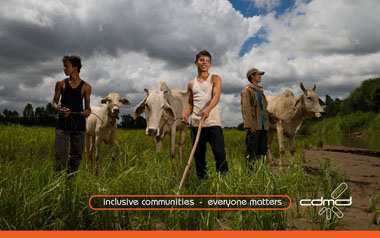
Slide 2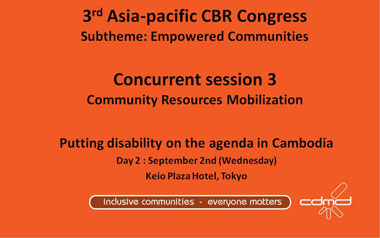 (Slide 2 text)
(Slide 2 text)
Slide 3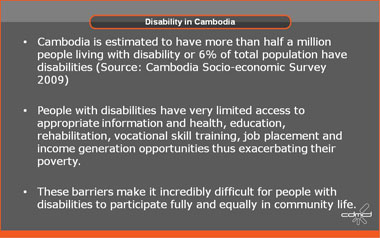 (Slide 3 text)
(Slide 3 text)
Slide 4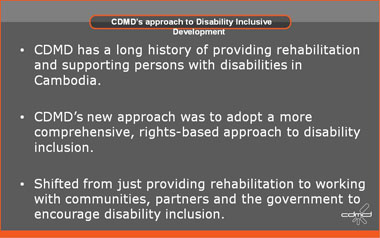 (Slide 4 text)
(Slide 4 text)
Slide 5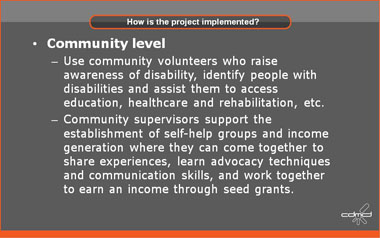 (Slide 5 text)
(Slide 5 text)
Slide 6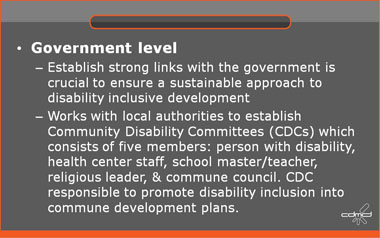 (Slide 6 text)
(Slide 6 text)
Slide 7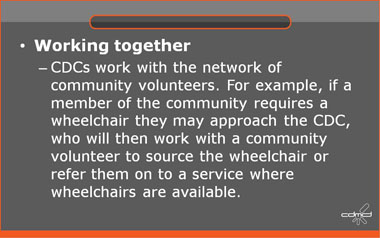 (Slide 7 text)
(Slide 7 text)
Slide 8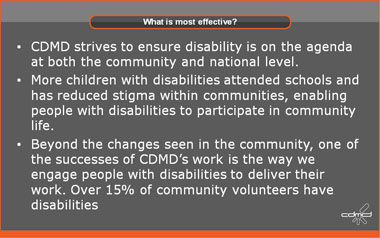 (Slide 8 text)
(Slide 8 text)
Slide 9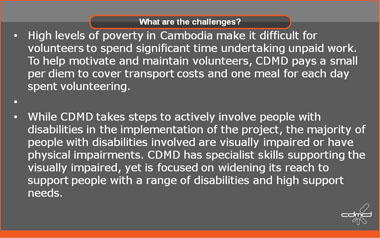 (Slide 9 text)
(Slide 9 text)
Slide 10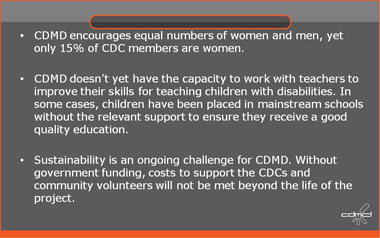 (Slide 10 text)
(Slide 10 text)
Slide 11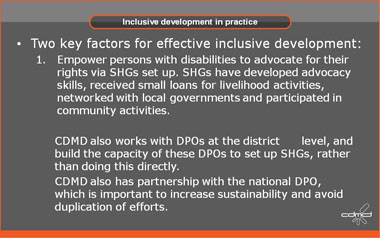 (Slide 11 text)
(Slide 11 text)
Slide 12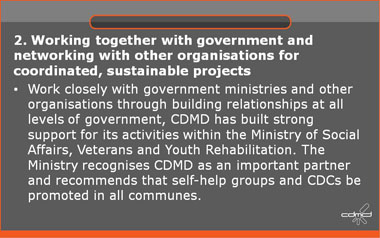 (Slide 12 text)
(Slide 12 text)
Slide 13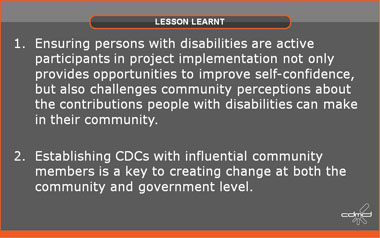 (Slide 13 text)
(Slide 13 text)
Slide 14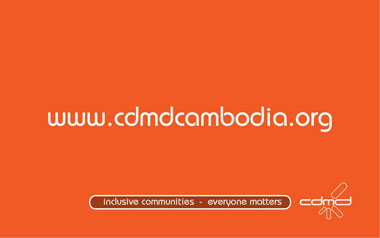 (Slide 14 text)
(Slide 14 text)
